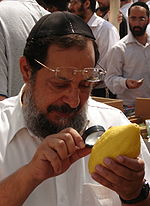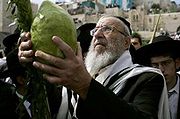
Yemenite citron
Encyclopedia

Yemen
The Republic of Yemen , commonly known as Yemen , is a country located in the Middle East, occupying the southwestern to southern end of the Arabian Peninsula. It is bordered by Saudi Arabia to the north, the Red Sea to the west, and Oman to the east....
ite citron
Citron
Not to be confused with Cintron.The citron is a fragrant citrus fruit, botanically classified as Citrus medica by both the Swingle and Tanaka systems...
' onMouseout='HidePop("17096")' href="/topics/Etrog">etrog
Etrog
Etrog refers to the yellow citron or Citrus medica used by Jews on the week-long holiday of Sukkot.While in modern Hebrew this is the name for any variety of citron, its English usage applies to those varieties and specimens used as one of the Four Species...
teimani) is a distinct variety, usually containing no juice vesicles
Juice vesicles
The juice vesicles of a citrus fruit are the membranous content of the fruit’s endocarp. The vesicles contain the juice of the fruit. The pulp is usually removed from the juice by filtering it out...
in its fruit's segments. The bearing tree is fairly bigger than the trees of the different varieties of citron, and the fruit's albedo is notably juicier.
Classification

Genetics
Genetics , a discipline of biology, is the science of genes, heredity, and variation in living organisms....
relation with the rest of the types
Etrog
Etrog refers to the yellow citron or Citrus medica used by Jews on the week-long holiday of Sukkot.While in modern Hebrew this is the name for any variety of citron, its English usage applies to those varieties and specimens used as one of the Four Species...
. A brief documentation of this study was presented at the Global Citrus Germplasm Network.
Although other varieties of pulpless citron, such as Buddha's hand
Buddha's hand
Buddha's hand, Citrus medica var. sarcodactylis , is a fragrant citron variety whose fruit is segmented into finger-like sections. The origin of Buddha's hand plant is traced back to Northeastern India or China.-Description:Citrus medica var...
, can be found in India and China, most Jewish cultures are not aware of them. The Yemenite Jews
Yemenite Jews
Yemenite Jews are those Jews who live, or whose recent ancestors lived, in Yemen . Between June 1949 and September 1950, the overwhelming majority of Yemen's Jewish population was transported to Israel in Operation Magic Carpet...
say it went with them through tradition, and even believe it was in their hands since The First Temple.
Some argue that the absence of pulp is clear evidence for its genetic purity, and that other varieties developed a pulp due to being grafted
Grafting
Grafting is a horticultural technique whereby tissues from one plant are inserted into those of another so that the two sets of vascular tissues may join together. This vascular joining is called inosculation...
upon Lemon
Lemon
The lemon is both a small evergreen tree native to Asia, and the tree's ellipsoidal yellow fruit. The fruit is used for culinary and non-culinary purposes throughout the world – primarily for its juice, though the pulp and rind are also used, mainly in cooking and baking...
or Orange
Orange (fruit)
An orange—specifically, the sweet orange—is the citrus Citrus × sinensis and its fruit. It is the most commonly grown tree fruit in the world....
rootstock. This assertion is contested by virtue of the fact that the fruits of a Yemenite tree at the Citrus Variety Collection
University of California, Riverside Citrus Variety Collection
The UCR Citrus Variety Collection is one of the most important collections of citrus diversity in the world. It is used for research, breeding, and educational extension activities on the UC Riverside campus in Riverside, California....
contain no pulp despite being grafted on foreign rootstock.
Current research shows that grafting would not result in any hybridization, which can only be obtained by cross breeding achieved by applying the pollen
Pollen
Pollen is a fine to coarse powder containing the microgametophytes of seed plants, which produce the male gametes . Pollen grains have a hard coat that protects the sperm cells during the process of their movement from the stamens to the pistil of flowering plants or from the male cone to the...
of one variety or species to the style
Gynoecium
Gynoecium is most commonly used as a collective term for all carpels in a flower. A carpel is the ovule and seed producing reproductive organ in flowering plants. Carpels are derived from ovule-bearing leaves which evolved to form a closed structure containing the ovules...
of another species. In light of this, there is no reason to question one traditional variety more than another, especially when the above genetic
Genetics
Genetics , a discipline of biology, is the science of genes, heredity, and variation in living organisms....
study shows equal purity for all. In particular it shows high affiliation between the "Yemenite" kind and the Diamante citron
Diamante citron
The Diamante citron is a variety of citron named after the city of Diamante which is its most known cultivation point. Diamante is located in the province of Cosenza, Calabria, on the south-western coast of Italy...
. However this is not a proof for the etrog
Etrog
Etrog refers to the yellow citron or Citrus medica used by Jews on the week-long holiday of Sukkot.While in modern Hebrew this is the name for any variety of citron, its English usage applies to those varieties and specimens used as one of the Four Species...
s from every individual grower.
Etrog haCushi
Etrog haCushi is mentioned in the MishnahMishnah
The Mishnah or Mishna is the first major written redaction of the Jewish oral traditions called the "Oral Torah". It is also the first major work of Rabbinic Judaism. It was redacted c...
as well as in both the Babylonian (Succa 36a) and the Jerusalem Talmud
Jerusalem Talmud
The Jerusalem Talmud, talmud meaning "instruction", "learning", , is a collection of Rabbinic notes on the 2nd-century Mishnah which was compiled in the Land of Israel during the 4th-5th century. The voluminous text is also known as the Palestinian Talmud or Talmud de-Eretz Yisrael...
(Succa 3:6). The most common interpretation is that the Biblical Cush
Biblical Cush
Cush was the eldest son of Ham, brother of Mizraim , Canaan and the father of Nimrod, and Raamah, mentioned in the "Table of Nations" in the Genesis 10:6 and I Chronicles 1:8...
refers to Ethiopia
Ethiopia
Ethiopia , officially known as the Federal Democratic Republic of Ethiopia, is a country located in the Horn of Africa. It is the second-most populous nation in Africa, with over 82 million inhabitants, and the tenth-largest by area, occupying 1,100,000 km2...
, and therefor Etrog haKuschi should also refer to something which could be called the Ethiopian citron.
The Ethiopian Jews did not follow the mitzva of four species
Four Species
The four species are four plants mentioned in the Torah as being relevant to Sukkot. Karaite Jews build their Sukkot out of branches from the four specified plants , while Talmudic Jews take three types of branches and one type of fruit which are held together and waved in a special ceremony...
, even though they did anticipate the Sukkot
Sukkot
Sukkot is a Biblical holiday celebrated on the 15th day of the month of Tishrei . It is one of the three biblically mandated festivals Shalosh regalim on which Hebrews were commanded to make a pilgrimage to the Temple in Jerusalem.The holiday lasts seven days...
festival, as well as the rest of the Jewish ethnic divisions
Jewish ethnic divisions
Jewish ethnic divisions refers to a number of distinct communities within the world's ethnically Jewish population. Although considered one single self-identifying ethnicity, there are distinct ethnic divisions among Jews, most of which are primarily the result of geographic branching from an...
. This may have been due to their lack of ability to procure the species. Some believe that this is due to some Karaite influence, whose biblical interpretation indicates that the four species are only used as roofing for a sukkah
Sukkah
A sukkah is a temporary hut constructed for use during the week-long Jewish festival of Sukkot. It is topped with branches and often well decorated with autumnal, harvest or Judaic themes...
(the S'chach), and not for a separate waving ritual.
However, the Yemenite citron is available in Ethiopia and its markets, where it is sold for consumption. According to Erich Isaac, the late researcher of citrus distribution, the Yemenite citron is synonymous with the Ethiopian citron as a result of Ethiopian rule of Yemen in the past.

